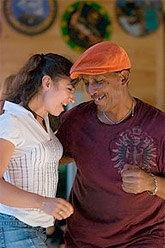 Steven Mitchell and Virginie Jensen are easily two of the most talented, respected, innovative and influential dancers and teachers in the Lindy Hop community today. Indeed, you will be hard pressed to find a serious professional or competitive Lindy Hop dancer who hasn’t been influenced by this dance couple.
Steven Mitchell and Virginie Jensen are easily two of the most talented, respected, innovative and influential dancers and teachers in the Lindy Hop community today. Indeed, you will be hard pressed to find a serious professional or competitive Lindy Hop dancer who hasn’t been influenced by this dance couple.
By the time Steven and Virginie had teamed up officially in 1999 as international dance instructors, they had already developed a deep store of dance skill and knowledge through their own individual dance studies. Steven Mitchell had studied Jazz, Ballet, Modern, Ballroom & Hip Hop in Los Angeles and New York, and along with one of his original swing dance partners, Erin Stevens, had studied extensively with legendary Lindy Hoppers Al Minns & Frankie Manning.
Virginie, who had studied Jazz, Classical Ballroom, Swing and Ballet extensively for 20 years, had been teaching and performing since age 16. A lesser known fact is that Virginie actually began swing dancing in the SF Bay Area, was an early attendee of Lindy in the Park, and taught with then local swing dance teacher Chad Kubo before she formed her partnership with Steven.
[tubepress video=”xz6_NxtlkfM”]
My first experiences with Steven & Virginie was in workshop classes at the Oakland Swing Dance Festival in 2002 and 2003. My main Lindy Hop teachers at the time, Paul Overton & Sharon Ashe, had been raving for weeks for us students to seize the opportunity to learn from Steven & Virginie. Naturally, I had to see what all the fuss was about, so I did.
I remember two classes with them. The earlier class with Virginie focused on personal body movement, and how to connect with and move across the dance floor. There were no 8-counts, or 6-counts, triple steps or lead and follow, just rows of dancers relearning to walk across a dance floor with grace, power and style. In her endearing  French accent, she explained how to move from one’s “heeps” (i.e. hips) and center, and how to propel oneself across the floor by pushing through every step. Students also benefited from her extensive classical, jazz and ballet training as she covered how to turn and spin in a balanced and graceful manner.
The second class I remember, taught by both Steven and Virginie, gave me a whole new perspective on the swingout. In a teaching approach that is uniquely theirs, they avoided complicated technical explanations and jargon, and instead presented their material in simple visual and auditory terms, whittling the swingout to it’s bare essence: drawing one’s partner in, embracing them, and then sending them away. They built the movement up in stages:
- Â just holding hands in open position, walking in place, one step on every beat (no triple steps!)
- same as the previous – walking, single steps on each beat – but leaders draw their partner toward them for the first half (first 4 counts), embrace partner briefly (count 4,5), send partner back out the way they came in for the second half (last 4 counts). Essentially, an 8-count sugar push with no triple steps.
- same as the previous, but leaders rotate slightly around counts 4-5, so that they send their follower out 180 degrees opposite the way they came in. Basically, a half-swingout.
- same as the previous, but leaders revolve 360 degrees while embracing their partner around counts 4-5, still just single stepping on every beat. Basically, a swingout, without the triple steps.
- same as the previous, but finally inserting triple steps on 3-and-4 and 7-and-8, making it a full, recognizable Lindy Hop swingout
Although I’ve deconstructed their lesson plan analytically, the real value in the lesson was the nuanced connection and the feeling of the swingout that they conveyed. Steven – who is incidentally a passionate singer and who is often be found singing onstage with the bands at world swing dance events – would vocalize what he and Virginie were feeling in the middle of those swingouts,and what they wanted you and your partner to experience yourself.  You could hear the power and gentle flow of their movements as they exclaimed “ooooh” and “ahhh” (tastefully, mind you), during the embrace of their swingouts, to express what was happening physically.
My overall point is that learning from Steven & Virginie is an experience in itself, and one that I highly recommend you try. Luckily, they are highly sought after instructors on the Lindy Hop and Blues dance teaching circuits, and you’ll find them as featured instructors at many national and international dance workshop and camps. Check them out at event such as Houston’s Southwest LindyFest (March),  Herrang Dance Camp (July), Swingout New Hampshire (Labor Day Weekend, August/September) and Denver’s Lindy Diversion (October), among others. Or catch them at their annual event in Rochester:
[tubepress video=”qr00LktWL0o”]
Also, another little know fact, is that Virginie still resides in the Bay Area, and comes out to swing dance every now and then at Cat’s Corner and the 9:20 Special. Nathan has been talking to Virginie about bringing her out of hiding, so that a whole new generation of Bay Area swing dancers can benefit from her unique experience and take on dancing. Be sure you’re signed up for the Swing or Nothing and/or Cat’s Corner newsletters to keep up-to-date as that develops!
